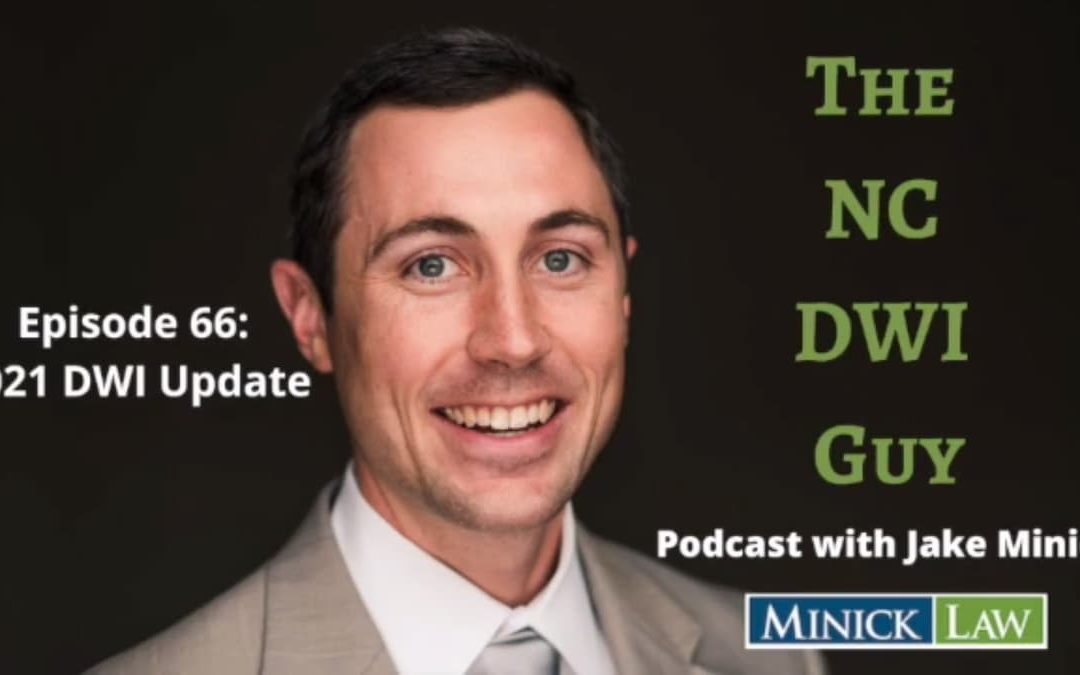In this episode of the NC DWI Guy, Jake takes us on a tour of recent North Carolina Appellate Decisions that touch on various aspects of DWI cases. If you want a good summary of the legal decisions from the last few years dealing with DWI cases and how to utilize the holdings of these cases in defending your client, look no further.
CHECKPOINTS
State v. Macke, ___ N.C. App. ___ (March 16, 2021)
Facts: SHP conducted a license and DWI checkpoint in compliance NCSHP policy and with the prior authorization for the checkpoint. The written plan of SHP changed the location of the checkpoint location every thirty minutes to avoid identification of the checkpoint on a mobile direction application.
Holding: The trial court did not err in finding the primary programmatic purpose of the checkpoint was “to check for a valid driver’s license and evidence of impairment” based on the testimony of the Troopers at the suppression hearing.
Notes and Quotes: The location of the checkpoint changed several times, but this did not impact the validity of the checkpoint as the changes to the location of the checkpoint were planned in advance.
Distinguish from State v. Rose, 170 N.C. App. 284, 291-97, 612 S.E.2d 336, 341-44 (2005), “wherein officers admitted there was not an established plan before the checkpoint was set up.”
COMMUNITY CARETAKING
State v. Brown, 827 S.E.2d 534 (April 16, 2019)
Facts: Officer was standing outside his patrol vehicle when Defendant’s vehicle drove by and the officer heard the words “mother fucker” coming from inside the vehicle. The officer was concerned that there was an argument or possible domestic violence situation occurring and got in his vehicle and caught up to Defendant’s vehicle and ultimately initiated a traffic stop.
Holding: The community caretaking “exception should be applied narrowly and carefully to mitigate the risk of abuse.” Therefore, “cases where the community caretaking doctrine has been held to justify a warrantless search, unquestionably suggest a public safety issue. There are no such facts in this case.”
Notes and Quotes: To argue that the community caretaking exception to the warrant requirement applies the State has the burden of proving that: (1) a search or seizure within the meaning of the Fourth Amendment has occurred; (2) if so, that under the totality of the circumstances an objectively reasonable basis for a community caretaking function is shown; and (3) if so, that the public need or interest outweighs the intrusion upon the privacy of the individual. The Court noted that in assessing the third prong of this test, the Court has previously listed considerations in assessing the weight of the public interest against the intrusion on the individual’s privacy. State v. Smathers, 232 N.C. App. 120, 753 S.E.2d 380 (2014).
REASONABLE SUSPICION
State v. Carver, 265 N.C. App. 501, 828 S.E.2d 195 (May 21, 2019)
Facts: Police responded to an anonymous call about a vehicle being in a ditch possibly connected with a “drunk driver, someone intoxicated,” and that a “truck was attempting– getting ready to pull them out.” Police received no information about the car, the truck, or the driver. The deputy responded to the area the tipster had given as the location of the accident and found a white Cadillac partially in someone’s driveway at an angle. The vehicle had mud on the driver’s side. The responding officer did not observe anyone in or around the vehicle as he passed. As the officer continued driving he observed a truck “a couple of hundred feet” from where the Cadillac was parked travelling away from his location. When he caught up to the truck he estimated the truck was travelling 15 to 20 miles under the posted speed limit and “it was big enough to pull the car out.” The officer initiated a traffic stop.
Holding: Neither the anonymous tip nor the officer’s independent investigation provided reasonable articulable suspension to stop.
Notes and Quotes: “The anonymous tip ‘reported no crime and was only partially correct,’ and ‘it merely described the individual as ‘suspicious’ without any indication as to why.’” Quoting United States v. Sokolow, 490 U.S. 1, 15 (1989). “The type of detail provided in the [anonymous] tip and corroborated by the officers is critical in determining whether the tip can supply the reasonable suspicion necessary for the stop. Where the detail contained in the tip merely concerns identifying characteristics, an officer’s confirmation of these details will not legitimize the tip.” Id. at 12.
State v. Orr, ___ N.C. App. ___, 831 S.E.2d 660 (September 3, 2019) (Unpublished)
Holding: Defendant’s weaving within his own lane “constantly and continuously” for a mile while simultaneously coming very near to hitting the curb, crossing onto the centerline and almost causing multiple head-on collisions, and forcing on-coming drivers to move toward the right side of their lane created reasonable articulable suspicion to stop Defendant’s vehicle.
HORIZONTAL GAZE NYSTAGMUS
State v. Ammons, ___ N.C. App. ___, 832 S.E2d 273 (September 17, 2019) (unpublished)
Facts: Over Defendant’s objection, the charging officer testified that his opinion based on the HGN testing he conducted of Defendant was that Defendant was appreciably impaired. The officer explained that he was certified in field sobriety tests through the North Carolina Highway Patrol and had received an annual up-todate refresher in this field of forensic testing. He also testified that he had arrested well over 200 impaired drivers and that based on his training and experience, HGN testing was a reliable indicator that a person was impaired by alcohol. He went on to describe the procedure followed by officers in the field when conducting HGN testing, and the results of his HGN testing of Defendant, which led him to conclude that Defendant was appreciably impaired by alcohol.
Holding: In overruling the Defendant’s objection on this testimony, the trial court implicitly found the officer was qualified to testify as an expert on the issue of impairment as it related to the horizontal gaze nystagmus. No error.
PROBABLE CAUSE
State v. Ezzell, ___ N.C. App. ___ (May 4, 2021)
Holding: In a probable cause hearing the Court is not bound by the rules of evidence.
State v. Fields, 268 N.C. App. 561, 836 S.E.2d 886 (December 3, 2019)
Facts: Police received a call to respond to a green pickup truck driving erratically and attempting to hit people. Officer Macaluso attempted to locate the vehicle and was flagged down by an intoxicated man telling him about the vehicle trying to run people over. Macaluso saw a vehicle that fit the description from dispatch passing by but the trial court found that Macaluso could not identify the driver. The green pickup truck was not driving erratically or committing traffic violations and Macaluso did not follow the truck. About two minutes later, the Defendant approached the area where Macaluso was speaking with a group of people. Macaluso noticed that Defendant was unsteady on his feet and had slurred speech. The Defendant appeared angry and complained he had been sold “fake crack.” Macaluso called in Officer Munter to investigate the DWI. Munter located a green pickup track nearby and found an empty liquor bottle in the back of the truck. Munter conducted various field sobriety tests on Defendant, including HGN, and Defendant showed 6 of 6 clues on the HGN.
Holding: Where officers did not observe Defendant driving and the State failed to establish a connection between the driver of the green pickup truck and the Defendant, no probable cause existed to arrest the Defendant for driving while impaired.
State v. Parisi, 372 N.C. 639, 831 S.E.2d 236 (August 16, 2019)
Facts: Defendant was stopped at a checking station. The stopping officer noticed an odor of alcohol about Defendant’s person, that Defendant’s eyes were red and glassy, the Defendant admitted to consuming three beers earlier that evening, and that Defendant exhibited 6 of 6 clues on the horizontal gaze nystagmus test, 1 of 8 clues on the walk and turn test, and 2 of 4 clues on the one leg stand test.
Holding: These facts constitute probable cause for the officer to arrest.
State v. Terrell, 263 N.C. App. 595, 822 S.E.2d 17 (January 15, 2019) (Unpublished)
Facts: An off-duty police officer was working security detail outside of a nightclub. The officer saw Defendant back out of a parking space and strike another vehicle at a low speed. The officer did not notice any damage to the vehicle that was struck. The officer noticed a strong odor of an alcoholic beverage coming from the breath of Defendant. Defendant took “several minutes” to produce his driver’s license upon the officer’s request. The off-duty officer interacted with the Defendant for close to an hour before requesting another officer to respond. During this near one-hour period, the off-duty officer testified that Defendant was not free to leave. The on-duty officer that responded arrived and looked at the vehicle, took pictures, and did SFSTs with Defendant before placing him under arrest.
Holding: The one-hour detention of Defendant constituted a de facto arrest requiring probable cause. “While the odor of alcohol and the fact that Defendant backed into a parked car would have given Officer Artieri reasonably suspicion to initially detain him, these circumstances did not – without more – constitute probable cause to actually arrest Defendant for driving while impaired.”
Notes and Quotes: In assessing whether a seizure constituted a de facto arrest, reviewing courts should determine whether law enforcement officers “diligently pursued a means of investigation that was likely to confirm or dispel their suspicions quickly, during which time it was necessary to detain the Defendant.” United States v. Sharpe, 470 U.S. 675, 686, 84 L. Ed. 2d 605, 616 (1985). “Although length in and of itself will not normally convert an otherwise valid seizure into a de facto arrest, where the detention is more than momentary, as here, there must be some strong justification for the delay to avoid rendering the seizure unreasonable.” Thorpe, 232 N.C. App. at 481, 754 S.E.2d at 223.
BLOOD DRAW
State v. Hoque, 269 N.C. App. 347, 837 S.E.2d 464 (January 7, 2020)
Holding: The use of force in taking the blood sample in this case was caused by Defendant’s refusal to comply with a lawful search warrant and was therefore reasonable.
SUFFICIENCY OF EVIDENCE
State v. Nazzal, 270 N.C. App. 345, 840 S.E.2d 881 (March 3, 2020)
Facts: Nolasco was involved in a single-vehicle accident on I-40 in Orange County. Road conditions were wet and icy. A tow truck came out to address this wreck and was trying to move Nolasco’s vehicle out of the roadway. Mr. Nolasco was standing at the roadside when another vehicle travelling on I-40 driven by Defendant hit Nolasco. The tow truck driver went to assist Nolasco. The tow truck driver tried to signal oncoming cars but they could not see him and he had to leave Nolasco to preserve his own safety. Another vehicle travelling about 40 seconds behind Defendant’s vehicle then ran over Nolasco. The tow truck driver testified that he believed Nolasco was dead before the second car ran over Nolasco. Defendant left the scene prior to any police arriving. Troopers arrived on scene to investigate the accident and death of Nolasco. Troopers uncovered evidence leading them to believe that the vehicle which had initially hit Nolasco belonged to Defendant. They contacted the Guilford County Sherriff’s Office for assistance in locating the Defendant. Deputies arrived at Defendant’s residence and found a vehicle matching the description of the one that had hit Nolasco with significant damage. Deputies made contact with the Defendant who indicated that the car had been involved in a collision but “it wasn’t a very bad one” so he drove away. Defendant was initially arrested for felony hit and run, but on the way to the sheriff’s office, the Trooper indicated that he formed an opinion that Defendant was impaired. The Trooper observed Defendant had red, glassy eyes, was unsteady on his feet, and at times was “speaking out of his head” and “rambling” nonsensically. Defendant fell asleep on the road to the sheriff’s office despite having just received the jarring news that he had killed a man. No SFSTs were performed on Defendant. The jury returned a verdict of guilty for DWI, felony hit and run, felony death by vehicle and second-degree murder.
Holding: The trial court erred by denying the Defendant’s motion to dismiss at the close of the State’s evidence on the charges of DWI and felony death by vehicle for lack of sufficient evidence to proceed on those charges. “The State argues that the signs of impairment observed by Trooper Underwood five hours later, when coupled with the very nature of the collision, Defendant’s immediate flight from the scene, and his gross understatement of the collision’s severity, provide substantial evidence that the Defendant was appreciably impaired at the time of the collision. We disagree.”
Notes and Quotes: The court based its decision primarily on State v. Eldred, 259 N.C. App. 345, 815 S.E.2d 742 (2018).
JURY INSTRUCTIONS
State v. Hernandez, ___ N.C. App. ___ (April 20, 2021) (unpublished)
Facts: Defendant was charged with driving while impaired and requested to submit to a blood test, which she initially refused. After the charging officer obtained a search warrant for blood, Defendant gave consent for the blood to be searched.
Holding: The trial court did not err when instructing the jury that they could interpret the Defendant’s initial refusal of a blood test as evidence of guilt when considering together with all the other evidence, including her subsequent agreement. N.C.G.S. § 20-139.1(f).
SENTENCING
State v. Altman, ___ N.C. App. ___, 824 S.E.2d 211 (March 5, 2019) (Unpublished)
Holding: Driving while impaired is a lessor-included offense of felony death by vehicle and the two convictions should have necessarily merged.
State v. Hughes, 265 N.C. App. 80, 827 S.E.2d 318 (April 16, 2019)
Procedural History: At district court Defendant was convicted of DWI and the trial judge found Defendant to be a Level 1 based on the fact that Defendant’s drivers license was revoked for a prior DWI and the Defendant had a prior DWI conviction within seven years. Defendant appealed to superior court and the State never gave notice to the Defendant of intent to use aggravating factors. The Defendant was convicted in superior court and the superior court judge used the same factors as had been used at district court to sentence the Defendant to a Level 1 sentence.
Holding: When the State fails to give notice of its intent to use aggravating sentencing factors as required by N.C.G.S. § 20-179 (a1)(1), the trial court’s use of those factors in determining a defendant’s sentencing level is reversable error.
Notes and Quotes: On appeal, the State argued that Defendant received constructive notice of the aggravating factors because they were used at the earlier district court proceeding, and because Defendant didn’t contest the existence of the aggravating factors themselves, any additional notice would not have changed the result at sentencing. The Court of Appeals disagreed, reasoning that allowing the State to fulfill its notice obligation by relying on district court proceedings would render the sentencing statute effectively meaningless. The statute requires the State to provide notice of its intent to use aggravating factors only “[i]f the defendant appeals to superior court.” N.C. Gen. Stat. § 20-179(a1)(1) (emphasis added).”
State v. McGaha, ___ N.C. App. ___, 851 S.E.2d 659 (November 3, 2020)
Holding: The requirement of the State to give notice of aggravating factors can be waived by defense and was waived in this case due to Defendant admitting to the prior conviction, defense counsel stipulating to Defendant’s prior conviction, and no objection from the Defendant during sentencing that the prior conviction was being used as an aggravating factor. Distinguishes from Hughes, were the Defendant specifically objected to the lack of notice, and this Court stated that the record before it “does not indicate that Defendant waived his right to receive such notice.” 265 N.C. App. At 81, 84, 827 S.E.2d at 320, 322.
































